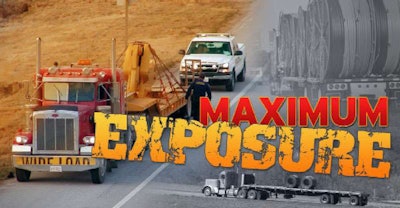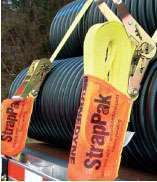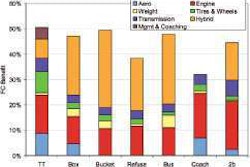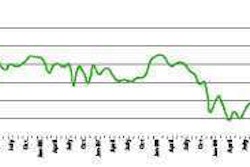Open deck carriers face more scrutiny under CSA 2010’s cargo-related BASIC.

But one new safety category exposes open deck carriers in particular to a new set of worries. Specifically, CSA 2010 breaks cargo-related issues – currently lumped into SafeStat’s Vehicle SEA – into a category of its own, with a heavy emphasis on load securement. Although the category includes all carriers and load types, open deck carriers – whose loads are visible at all times by local and state law enforcement and scale-house operators – will face the lion’s share of scrutiny under the new system.
When FMCSA first designed the BASICs structure, the agency recognized that issues such as cargo and tiedown regulations aren’t necessarily associated with the integrity of the vehicle itself or whether or not the vehicle is maintained, so it created a new category. It also wanted to identify the potential impact of improperly secured loads on crash causation.
Another difference between CSA 2010 and its predecessor that affects open deck carriers is in the unsafe driving BASIC. “Speed and permitting issues were never on the radar because they didn’t pop up on the SEA value,” says Capt. Dan Meyer, Kansas Highway Patrol and head of the Commercial Vehicle Safety Alliance’s Driver Traffic Enforcement Committee. “The weight and oversize violations cited by states fall under [FMCSR Part] 392.2 local law definitions. That goes into the unsafe driving BASIC. If they aren’t properly loaded or don’t have proper permits, they can accumulate points for those violations.”
Point system up for debate
Each violation under CSA 2010, whether out-of-service or not, is assigned a severity weight – 1 through 10, with 10 being the most severe – based on the likelihood the violation may contribute to a crash. Dean Newell, vice president of safety and driver training for Little Rock, Ark.-based Maverick Transportation, has concerns with how FMCSA has assigned point values to some of the violations and how they are enforced, echoing the sentiment among many open deck carriers.
“If the law says a load requires five securement devices, we normally require our drivers to use six or seven,” Newell says. “If a driver gets pulled over and has five securements that are tight and one that is loose, that counts as a violation, even if the loose strap is the extra one that wasn’t required to begin with. That is going a little too far.”
Industry leaders are calling for FMCSA to re-evaluate the severity weight structure for load securement violations and place a higher weight on out-of-service violations and lower points on other violations. “If it doesn’t put you out of service, it shouldn’t cost you 10 points,” says Gary Salisbury, president and chief executive officer of Hope, Ark.-based Fikes Truck Line and chairman of the Truckload Carriers Association’s Open Deck Division. “Once CSA 2010 gets out and we get used to it, it will be a great thing, but it needs some tweaking. Safer roads above all – that is what the trucking industry wants.”
 Cargo securement device suppliers are coming to market with innovations to make proper cargo securements easier and more ergonomic. The StrapPak from Kinedyne securely bundles strap ends to prevent premature wear that could lead to a CSA 2010 violation.
Cargo securement device suppliers are coming to market with innovations to make proper cargo securements easier and more ergonomic. The StrapPak from Kinedyne securely bundles strap ends to prevent premature wear that could lead to a CSA 2010 violation.Recognizing the potential to improve the scoring system, FMCSA indicates it is willing to listen to industry groups and re-examine the severity weights assigned to certain violations, including cargo-related violations. “We’ve been hearing a lot of reaction from industry groups,” says Bryan Price, FMCSA senior transportation specialist. “We’re amenable to getting additional input from a group of industry and enforcement representatives on a completely different systematic approach to assigning these severity weights.”
A detailed description of all cargo-related BASIC violations can be found at http://csa2010.fmcsa.dot.gov/about/BASICs.aspx.
A separate hazmat category?
Another concern among flatbed carriers is the inclusion of hazardous material load violations under the cargo-related BASIC. TCA’s Open Deck Division has voiced its opposition, requesting FMCSA move hazmat out of the cargo-related BASIC because of the uniqueness of hazmat cargo. Also at issue is the disparity in severity weights between hazmat and load securement sections of the BASIC.
“The hazmat out-of-service rate is a totally distinct metric used by the FMCSA to determine the eligibility for a hazmat safety permit,” says Salisbury.
Hazmat violations were included in the cargo-related BASIC because the objective was to identify behaviors that result in crashes, and Price says hazmat noncompliance typically isn’t a behavior area that leads to crashes. “Hazmat issues in and of themselves don’t contribute to crash causation but can increase the consequence of a crash,” he says. “We’ve heard from several industry groups that hazmat deserves its own evaluation area. We haven’t closed the door on that idea.”
Hazmat violations historically are only a fraction of the violations the Kansas Highway Patrol sees roadside. “When I do a comparative analysis of a hazmat carrier versus other carriers, I find that they are a lot safer, and they have to be because of the product they’re hauling,” says Meyer. “The insurance company isn’t going to maintain them if they aren’t operating safely.”
Back to basics
Carriers themselves are going back to the drawing board to re-educate drivers on the increased scrutiny on and negative consequences of improperly secured loads. “Training is going to be essential,” says Salisbury. “It is going to be a paradigm shift in the industry – people have to start over from scratch and re-educate themselves on the importance of proper load securement.”
Industry leaders want FMCSA to re-evaluate the severity weight structure for load securement violations.
In December 2008, Newell and another Maverick vice president went on a two-week road trip, visiting with drivers at terminals to educate them on the pending CSA 2010 initiative. The company now addresses CSA 2010 at driver orientation and continues with education pieces on video carousels at terminals. “If the guys do it the way we train them, we should be OK,” he says.
Meyer recommends open deck carriers make themselves familiar with all the rules and regulations pertaining to load securement and take a proactive approach and engage law enforcement. “Once you have that knowledge, you are put in a position where you can not only ensure that you’re operating within the rules, but you can educate some roadside officers.”
Load securement solution providers such as Kinedyne are coming to the table with new product offerings to make load securement as easy and ergonomic as possible for drivers. It recently introduced a winch bar solution that allows the operator to ratchet the winch easily to achieve proper tension on the cargo strap to secure the load properly.
Today’s straps are made to withstand the elements better, but Larry Harrison, Kinedyne vice president of sales and marketing, says it’s best not to try to make them last longer than they should. “Straps are a commodity – automatically replace them at any sign of wear and tear, especially with the tightening-up of regulations.”
Teaching drivers about the increased scrutiny placed on load securement is the best way to ensure clean inspections once CSA 2010 comes online, Price says. “The bottom line is you don’t have anything to worry about if you’re in compliance.” n













